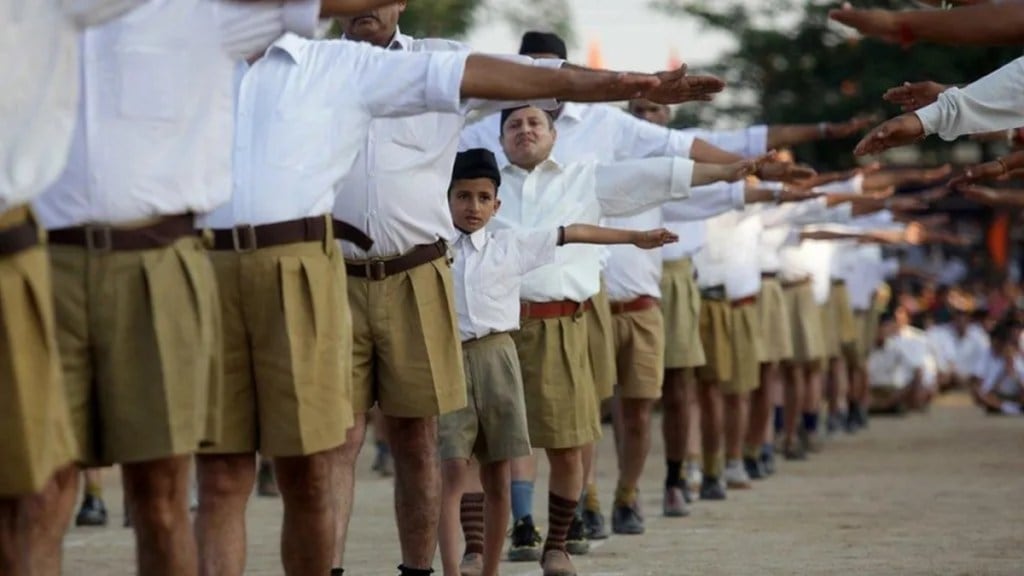The RSS’s changing ethos was very visible at its centenary celebrations in Delhi. RSS chief Mohan Bhagwat fielded questions from journalists for nearly three hours. His media team, modelled on corporate lines, invited both Indian and foreign journalists. Unfortunately, beat reporters who cover the Sangh daily were relegated to the back and foreign correspondents were seated in front. Translations of speeches into English, Spanish and French were available on headphones. Some 50 representatives from the diplomatic corps attended, including the ambassadors of China, Israel and Switzerland. In the last century, RSS supremos kept a low profile, with major ideological statements mostly limited to stray remarks on Vijayadashami. It was K Sudarshan who, during A B Vajpayee’s tenure, broke with tradition by appearing at the swearing-in ceremony of Vajpayee’s first Cabinet and reportedly influenced the choice of finance minister. While sleepy Nagpur still remains the Sangh’s official headquarters, most RSS key functionaries have started moving to the huge new complex in Delhi, with security checks and high-tech gadgets. Last year, the ban on government officers joining the RSS, never enforced except during the Emergency, was formally lifted. Bhagwat’s main message was to counter the narrative of the RSS’s detractors, that it is anti-minority and regressive in thought, an image that has harmed the BJP government in the Middle East and the West. Bhagwat stressed the RSS’s inclusive nature, and said caste and religion were not barriers, adding that he did not object if people preferred to speak in English. Muslims too were Indians who deserved respect, but he was against conversion, he said. Interestingly, a day later, US President Donald Trump’s hatchet man Peter Navarro tweeted a photograph of PM Narendra Modi taken during his 2024 campaign in Kanyakumari, meditating as a seer in saffron robes, with vibhuti and tilak smeared on his forehead, as if to reinforce an image of Hinduism as retrogressive. Navarro’s mischievous propaganda continued with him referring to New Delhi’s ruling elite as Brahmins.
An Unusual delay
Bhagwat denied a common perception, that the RSS was responsible for the delay in the selection of a new BJP chief. Party president J P Nadda has overstayed in his post by over 1.5 years, and the buzz is that there is no consensus between the RSS and the party over the choice of his successor. The BJP high command is keen on younger ministers, with whom it has worked closely in recent elections; the RSS would prefer an older, seasoned hand who would keep the Sangh in the loop. Bhagwat, while denying any RSS involvement, confirmed that there was an unusual delay. If the RSS had to decide, “it might not have taken so long”, he observed. He conceded that while the RSS office may make suggestions, the BJP makes up its own mind. He cautioned recruits that the RSS should not be looked upon as a stepping stone to the BJP. But the presence of advisers or officers with an RSS background in most Central government ministerial offices in recent years is noticeable. An RSS connection also helps for appointing governors and educational institution heads.
Yo-yo policy
The dramatic ups and downs in our foreign policy is such that most who deplore the end of the “Namaste Trump” bonhomie years with Modi, forget that in fact China under Xi Jinping was the first foreign power to perceive the political importance of Modi, when he was still Gujarat CM and unwelcome in the West, with the US denying him a visa. In contrast, the Mayor of Shenzhen, a Chinese SEZ zone, felicitated Modi. In 2011, a reception was held in Modi’s honour at the Great Hall of the People. Similarly, Xi was the first major foreign dignitary to be hosted by Modi on the banks of the Sabarmati after taking over as PM in 2014.
Rooms with view
The opinion of Central officers who were shifted from their old headquarters to the new lookalike six-storey Kartavya Bhavan on Kartavya Path depends on where they have been relocated from. Those working in 1960s-era buildings, such as Shastri Bhawan, see it as a change for the better, with glass windows, wide corridors and clean walls, in comparison to the deteriorating infrastructure of their old offices. But for those formerly lodged in the British-era North and South Blocks, with high ceilings, majestic staircases and a historic background that impressed visitors, it is a case of lese-majesty. The Intelligence Bureau, shifted to the top floor of Kartavya Bhavan 3, has additional handicaps. Supposedly secret sources are visible through the glass partitions and there is no space for the steel almirahs, which store crumbling paper files dating back to the Raj. The files cannot be digitised because of security concerns.

